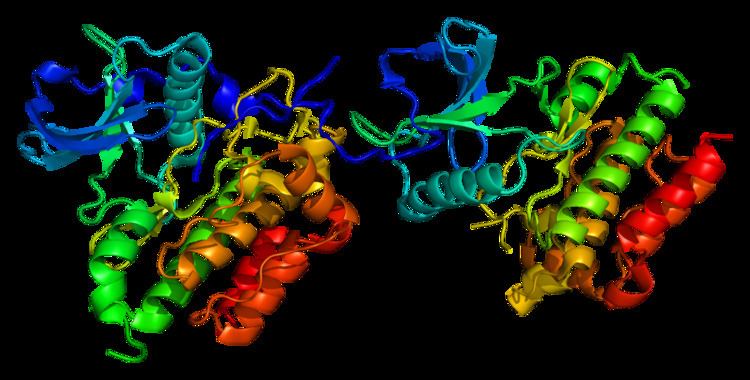Species Human Entrez 3815 | Human Mouse Ensembl ENSG00000157404 | |
 | ||
Aliases KIT, C-Kit, CD117, PBT, SCFR, KIT proto-oncogene receptor tyrosine kinase External IDs MGI: 96677 HomoloGene: 187 GeneCards: KIT | ||
Mast/stem cell growth factor receptor (SCFR), also known as proto-oncogene c-Kit or tyrosine-protein kinase Kit or CD117, is a receptor tyrosine kinase protein that in humans is encoded by the KIT gene. Multiple transcript variants encoding different isoforms have been found for this gene. KIT was first described by the German biochemist Axel Ullrich in 1987 as the cellular homolog of the feline sarcoma viral oncogene v-kit.
Contents
Cell surface marker
Cluster of differentiation (CD) molecules are markers on the cell surface, as recognized by specific sets of antibodies, used to identify the cell type, stage of differentiation and activity of a cell. CD117 is an important cell surface marker used to identify certain types of hematopoietic (blood) progenitors in the bone marrow. To be specific, hematopoietic stem cells (HSC), multipotent progenitors (MPP), and common myeloid progenitors (CMP) express high levels of CD117. Common lymphoid progenitors (CLP) express low surface levels of CD117. CD117 also identifies the earliest thymocyte progenitors in the thymus. To be specific, early T lineage progenitors (ETP/DN1) and DN2 thymocytes express high levels of c-Kit. It is also a marker for mouse prostate stem cells. In addition, mast cells, melanocytes in the skin, and interstitial cells of Cajal in the digestive tract express CD117.
Function
CD117 is a cytokine receptor expressed on the surface of hematopoietic stem cells as well as other cell types. Altered forms of this receptor may be associated with some types of cancer. CD117 is a receptor tyrosine kinase type III, which binds to stem cell factor (a substance that causes certain types of cells to grow), also known as "steel factor" or "c-kit ligand". When this receptor binds to stem cell factor (SCF) it forms a dimer that activates its intrinsic tyrosine kinase activity, that in turn phosphorylates and activates signal transduction molecules that propagate the signal in the cell. Signalling through CD117 plays a role in cell survival, proliferation, and differentiation.
Mobilization
Hematopoietic progenitor cells are normally present in the blood at low levels. Mobilization is the process by which progenitors are made to migrate from the bone marrow into the bloodstream, thus increasing their numbers in the blood. Mobilization is used clinically as a source of hematopoietic stem cells for hematopoietic stem cell transplantation (HSCT). Signaling through CD117 has been implicated in mobilization. At the current time, G-CSF is the main drug used for mobilization; it indirectly activates CD117. Plerixafor (an antagonist of CXCR4-SDF1) in combination with G-CSF, is also being used for mobilization of hematopoietic progenitor cells. Direct CD117 agonists are currently being developed as mobilization agents.
Role in cancer
Activating mutations in this gene are associated with gastrointestinal stromal tumors, testicular seminoma, mast cell disease, melanoma, acute myeloid leukemia, while inactivating mutations are associated with the genetic defect piebaldism.
Anti-KIT therapies
CD117 is a proto-oncogene, meaning that overexpression or mutations of this protein can lead to cancer. Seminomas, a subtype of testicular germ cell tumors, frequently have activating mutations in exon 17 of CD117. In addition, the gene encoding CD117 is frequently overexpressed and amplified in this tumor type, most commonly occurring as a single gene amplicon. Mutations of CD117 have also been implicated in leukemia, a cancer of hematopoietic progenitors, melanoma, mast cell disease, and gastrointestinal stromal tumors (GISTs). The efficacy of imatinib (trade name Gleevec), a CD117 inhibitor, is determined by the mutation status of CD117:
When the mutation has occurred in exon 11 (as is the case many times in GISTs), the tumors are responsive to imatinib. However, if the mutation occurs in exon 17 (as is often the case in seminomas and leukemias), the receptor is not inhibited by imatinib. In those cases other inhibitors such as dasatinib and nilotinib can be used. Researchers investigated the dynamic behavior of wild type and mutant D816H KIT receptor, and emphasized the extended A-loop (EAL) region (805-850) by conducting computational analysis. Their atomic investigation of mutant KIT receptor which emphasized on the EAL region provided a better insight into the understanding of the sunitinib resistance mechanism of the KIT receptor and could help to discover new therapeutics for KIT-based resistant tumor cells in GIST therapy.
The preclinical agent, KTN0182A, is an anti-KIT, Pyrrolobenzodiazepine (PBD)-containing antibody-drug conjugate which shows anti-tumor activity in vitro and in vivo against a range of tumor types.
Diagnostic relevance
Antibodies to CD117 are widely used in immunohistochemistry to help distinguish particular types of tumour in histological tissue sections. It is used primarily in the diagnosis of GISTs, which are positive for CD117, but negative for markers such as desmin and S-100, which are positive in smooth muscle and neural tumors, which have a similar appearance. In GISTs, CD117 staining is typically cytoplasmic, with stronger accentuation along the cell membranes. CD117 antibodies can also be used in the diagnosis of mast cell tumours and in distinguishing seminomas from embryonal carcinomas.
Interactions
CD117 has been shown to interact with:
